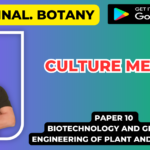![]()
Basic Concept and Principal of Biotechnology
Introduction
Biotechnology is the use of living systems and organisms to develop or make useful products. Modern biotechnology is mainly based on recombinant DNA (rDNA), and hybridoma technology is an addition to bioprocess technology. rDNA technology (recombinant DNA) is the main tool used to not only produce genetically modified organisms, including plants, animals, and microbes, but also to address the fundamental questions in the life sciences. In fact, modern biotechnology began when recombinant human insulin was produced and marketed in the United States in 1982. In recent years, biotechnology has assumed enormous significance due to its major impact on human welfare.
Concepts of Biotechnology
Biotechnology is the use of living systems and organisms to develop or make useful products, or “any technological” application that uses biological systems, living organisms, or derivatives to make or modify products or processes for specific uses.
For thousands of years, humankind has used biotechnology in agriculture, food production, and medicine.
In the late 20th and early 21st centuries, biotechnology has expanded to include new and diverse sciences such as genomics, recombinant gene technologies, applied immunology, and the development of pharmaceutical therapies and diagnostic tests.
Term coined by-Karl Ereky
” All lines of work by which products are produced from raw materials with the aid of living things.
European Federation of Biotechnology
Biotechnology is defined as the Integrated use of biochemistry, microbiology, and engineering science in order to achieve the technological application of the capabilities of microorganisms. Cultured tissue cells and part’s thereof.
Japanese biotechnology–
A technology using biological phenomena for copying and manufacturing various kinds of useful substances.
According to the U.S. National science foundation
the controlled use of biological agents such as microorganisms or cellular components for beneficial purposes.
IUPAC
the application of biochemistry, biology, and chemical engineering to industrial processes and products and the environment.
Smith
The formation of a new combination of heritable material by the insertion of Nucleic acid molecules produced by whatever means outside the cell into any virus, bacterial plasmid, or other vector system so as to allow their incorporation into a host organism in which they do not naturally occur but in which they are capable of continued propagation.













